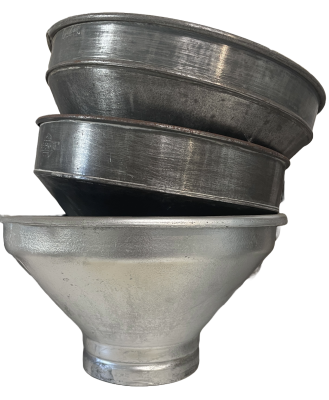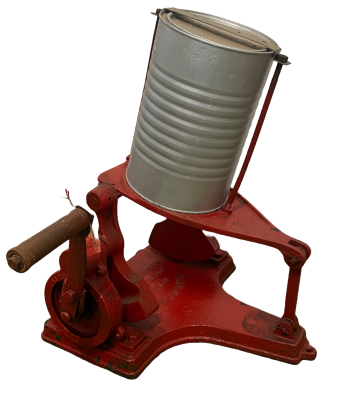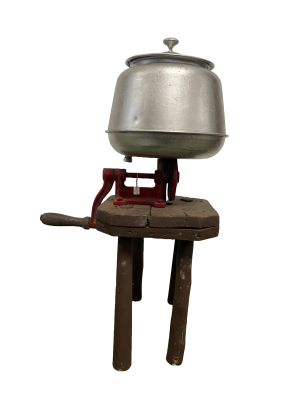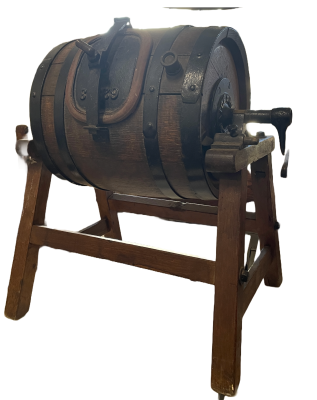Cherry & Sons Wooden Butter Churn
c. 1900 - 1930This a portable, hand-operated, wooden (kauri pine), box butter churn used to make butter from cream in the farm kitchen. The box has small feet that are carved out of the wooden sides. The wooden paddle inside is attached to a metal hand crank that has a turned wood handle. It has a detachable wooden lid and underneath the crank handle there is a worn transfer that had the directions for use. It could produce up to 12lbs of butter.
Edward Cherry migrated from Herefordshire England to Australia in 1855 and established a joinery workshop at Gisborne, Victoria. In 1858 he began experimenting with various models of butter churns and by 1875 had enough business to establish a factory. The Cherry works specialised in making all types of butter churns and equipment for both domestic use on farms and small butter factories. During the late nineteenth and early to mid twentieth centuries Cherry & Sons exported products to many countries around the world.
Edward Cherry ran the business with his sons until he died in 1909 and then the business was run by his son George until his death in 1917.
Details
Details
Manufacturer's name, location and the model is stenciled in black, on the exterior of the churn above the handle
CHERRY & SONS PTY LTD
GISBORNE VICTORIA
T1
The worn transfer under the handle provides maintenance instructions
DIRECTIONS
Scald with hot water each time before using, and then rinse with cold water; this prevents the grease getting into the pores of the wood and making the churn foul. Before putting away after use, scald until quite clean, then wipe dry and thoroughly air. Do not put the churn in the sun or wind to dry
Churn should not be filled more than two-thirds, nor handle turned more than 35 times per minute, for faster speed will only delay the coming of the butter. Today's cream should not be included, but should be put aside for next churning. Temperature of cream should be as nearly as possible 55 degrees.
CHERRY & SONS PTY. LTD., GISBORNE, VIC.
This butter churn would have been used in the farm kitchen. It would have been stored away until "butter making day" when it would be brought out and the stored, separated cream was poured in and then steadily churned to make butter. As the directions stated, churning faster would not make the butter any quicker!
Related Objects
Related Objects
Other items by Cherry & Sons
More items like this
Other items from Busselton Historical Society
- Framed Photograph - Busselton Centenary Parade 1932
- Framed Map - Busselton Municipal Boundaries c1900
- Painting by Matt Robinson - Vasse Hotel
- Section of the 1929 Wonnerup floodgates
- Painting by Matt Robinson - Busselton Jetty
- Butter Mallet
- Galvanised Cream Measuring cups and bucket
- Dazey Jar Churn
- Metal Milk Strainers
- Kangaroo Minute Butter Churn
- Sunrise Butter Churn mounted on wooden milking stool
- Oak Barrel Butter Churn on a stand
Scan this QR code to open this page on your phone ->









